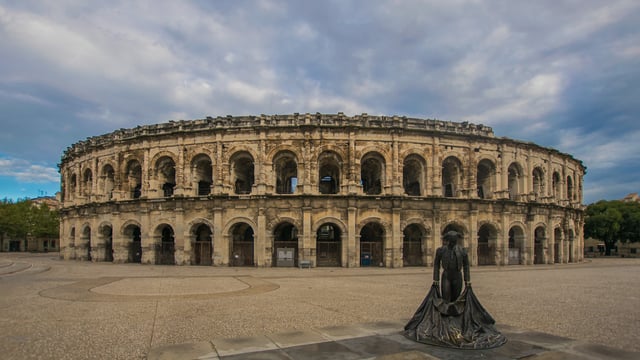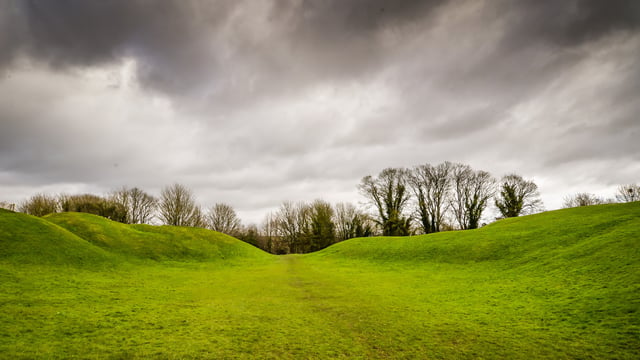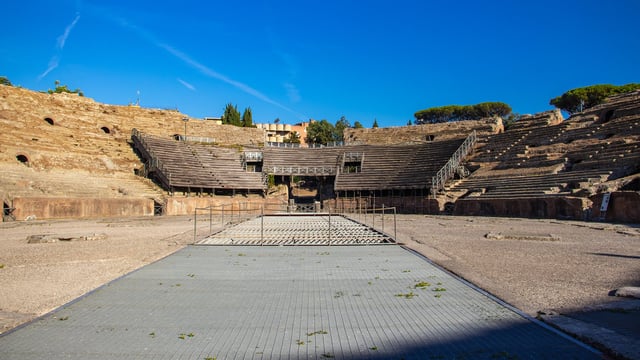Amphitheatres of the Roman World
Not all surviving amphitheatres are as spectacularly well preserved as the Colosseum in Rome, also known as the Flavian Amphitheatre. Although some are so well preserved they are still used for events and concerts today, such as the amphitheatre in Nîmes, there is very little left of others. Of the recently discovered London amphitheatre, for example, all that remains are the foundations of what served as the east gate to the arena. The manner in which these more modest remains have been prepared for display is sometimes quite exceptional – and for anyone exploring the history of this important city, this exhibition should not be overlooked.
Of course there is a whole range of partially and fully reconstructed amphitheatres. In the Provencal town of Fréjus in southern France, the restoration of the amphitheatre (photo at the top of this page) has enabled the remains of the Roman construction to be saved. While the amphitheatre in the Archaeological Park at Xanten in Germany is being rebuilt following the plans of its Roman predecessor. And for some, we just have a marker indicating where the amphitheatre once stood. Such as the amphitheatre in Ulpia Noviomagus Batavorum, modern day Nijmegen – the only known Roman amphitheatre in the Netherlands.
What Are Roman Amphitheatres?
Some amphitheatres were much more elaborate than others, but the common, basic structure is an open-air oval arena that is surrounded by raised seating.
Across the Empire they varied considerably in size, often reflecting the importance of the city or town which the building served. The Colosseum had an estimated seating capacity of between 50,000 and 80,000 people, while those amphitheatres in smaller Roman towns were only required to accommodate around 5,000 spectators.
Essentially, amphitheatres were used for gladiator combats, chariot races, animal slaying and executions. Other venues were used for other sporting and cultural activities: theatres were used for staging plays, pantomimes, choral events and orations; circuses and hippodromes for racing events; and stadia for athletics. Today amphitheatres are often confused with theatres, but there are differences between the two structures that relate principally to the events stages therein.
As action was the order of the day in an amphitheatre, seeing that action was more important than hearing it. The reverse being true for theatres. Consequently, theatres tend to be smaller and have much better acoustics. Perhaps the most fundamental difference between a Roman amphitheatre and a Roman theatre is the shape, theatres have a semi-circular arrangement of raised seating looking into a stage, whereas an amphitheatre is a ‘theatre in the round’ – amphi is Greek for around.
For more on the relationships between amphitheatres, theatres and odeia (sing. odeon), see this paper by Giulia Privitelli.
The Rise and Fall of the Roman Amphitheatre
Where and when the first amphitheatres were built is not known, but it is thought the earliest amphitheatres were wooden structures. The earliest stone amphitheatres date to the late Republic period, and the most well known example, certainly one of the best researched amphitheatre, can be seen at Pompeii – built after 70 BC. After 27 BC, the start of the Imperial Era, the amphitheatre spread throughout the Empire.
Amphitheatres not only became an important feature on the urban landscape, more crucially they played a significant role in the Romanisation of Provinces. For it was here that the Imperial cults and practices were played out in front of indigenous audiences. During the Imperial era amphitheatres became ever more more monumental and elaborate, with multi-storey, arcade façades decorated with marble and stucco cladding, statues and relief sculptures – everything we see at the Colosseum.
With the rise of Christianity in the Roman Empire, the kind of events staged in the amphitheatres attracted obvious disapproval. And, because Christian Romans then donated money to charity for divine reward in heaven, as opposed to Pagan Romans who funded public works and events to enhance their status, the financial support to stage the increasingly unpopular gladiatorial spectacles was difficult to find.
As amphitheatres began to have fewer uses, and no funds to maintain them let alone build new ones, they fell into disrepair and were dismantled for building materials, vandalised, or demolished to make way for other buildings. Some (Arles and Leptis Magna) were transformed into fortified settlements, others (Nîmes and Tarragona) became Christian churches, and even the Colosseum became a Christian shrine, when in 1749 Pope Benedict XIV declared it a sacred site where Christians had been slain.
Roman Amphitheatres
Amphitheatre of Serdica
In 2004 during excavations for the 5* Arena di Serdica Hotel builders came across a Roman wall. Following archaeological excavations, these remains turned out to be those of the amphitheatre built just outside the walls of the Roman city of Serdica. Coins discovered suggest that the structure was built in the 3rd or 4th century CE. And, beneath the amphitheatre are the remains of a 2nd century theatre. Remains of the amphitheatre have been restored for guests and visitors alike.

Arena of Nimes
The amphitheatre in Nîmes is widely regarded as one of the best preserved Roman amphitheatres. So well preserved is the structure that it is still used for a variety of events, although since 2009 it is in the process of being restored – a project that will last at least 25 years. It was built around 100 AD, shortly after the Colosseum in Rome, with an estimated seating capacity of 24,000. The amphitheatre was just inside the city wall, the position of which is marked in the paving surrounding the arena.

Arles Amphitheatre
One of the major attractions in Rome, the Arènes d’Arles was built by the Romans in the 1st century AD and is still used for entertainment today, as a venue for bullfighting during the Feria d’Arles in September and various musical events over summer. Although the structure is obviously Roman, it was modified during medieval times. The two towers are what remains of the amphitheatre as a fortress that up until the 18th century protected some 200 houses. These were removed in the 1820s.

Bordeaux Amphitheatre – Le Palais Gallien
A small part remains of what was once quite a large Roman amphitheatre, believed to have seated about 17,000 people. The amphitheatre was built in the 3rd century AD when Bordeaux, then known as Burdigala, was the capital of the Roman province of Aquitaine. It is thought that the amphitheatre was built to mark the visit to Aquitaine by the Emperor Lucius Septimius Bassianus. Visitors to Bordeaux will see the ruins called ‘Le Palais Gallien’, some say this is the palace Charlemagne had built for his wife Galiene.

Caerleon Amphitheatre
The modern town of Caerleon is built on the remains of a Roman legionary fortress and settlement that was known by the Latin name of Isca Silurum. Located on the edge of today’s town is the amphitheatre, a well preserved example built around 90 AD. Containing 8 entrances, it would have seated about 6,000 spectators eager to watch blood sports and gladiatorial combat. The 12th-century writer Geoffrey of Monmouth alleged that the amphitheatre, because of its shape, was King Arthur’s Round Table. Archaeologists excavated the amphitheatre in 1926.

Chester Roman Amphitheatre
Dating from the 1st century AD, the Chester’s amphitheatre is the largest known stone amphitheatre in Roman Britain. It was located southeast of the legionary fortress, and used for both entertainment and military training. Recent excavations revealed that by 120 AD the amphitheatre was all but abandoned, but it was bought back into use in around 275 AD following some rebuilding. It remained in use until about 350 AD. Today only two fifths of the amphitheatre is exposed, the rest lies unexcavated.

Cirencester Amphitheatre
On the outskirts of Cirencester are the remains of what was one of the largest amphitheatres in Roman Britain. At its maximum capacity it could have held around 8,000 people, there to watch animals and gladiators fight and be killed. It was fortified in the 5th century AD, a period of great turbulence. In the Middle Ages, the amphitheatre was converted into a rabbit warren and may also have been used for bull-bating. The site has been excavated by archaeologists and is freely accessible for those who want to visit.

Durrës Roman Amphitheatre
At 136 m by 113 m and seating an estimated 20,000 spectators, the Roman amphitheatre in Durrës is the largest on the Balkans peninsular. It was built in the second century BC during the reign of Emperor Trajan, and was still in use up until the 4th or 5th century AD. About a third of the structure was uncovered in the late 1960s, while the rest not until the 1980s. Preserved inside the ruins of the arena are the remains of a small chapel that is dedicated to the first bishop of Durrës Saint Astius.

Flavian Amphitheatre
The Flavian Amphitheatre in Pozzuoli is said to be the third largest Roman amphitheatre in Italy. Constructed during the first century AD, the amphitheatre is remarkably well preserved, with an interior that is mostly intact. Parts of the gears that were used to lift animal cages up on to the level of the arena can still be seen here. It is thought that this particular amphitheatre was built by the same architects that built the Colosseum in Rome – which was also known as the Flavian Amphitheatre.

Gennes Roman Amphitheatre
This Gallo-Roman amphitheatre is thought to have been one of the largest in north-west France. The typically elliptical arena measures 44 by 39 metres, with a semi-circular cavea thought to have been able to seat around 5,000 spectators. The basic outline and shape of the amphitheatre, as well as a number of architectural features, is well preserved and easy to see, but they have been enhanced by extensive excavations. These include three rooms at the edge of the arena that would have been used for performers.

London's Roman Amphitheatre
The east gate the London’s Roman amphitheatre was discovered underneath the Guildhall Art Gallery in 1985 during the construction of a building to replace the gallery building that was destroyed during World War II. These meagre remains have since been conserved in situ for visitors in the basement of the art gallery, next to London’s historic Guildhall. An innovative presentation adds to the archaeological remains to give you an idea of how 7,000 spectators would have been seated on tiered wooden seats.

Maumbury Rings
Maumbury Rings is an archaeological site that began as a Neolithic henge. The henge ditch was then modified by the Romans to create an amphitheatre. The oval flat area was the arena and the grass covered banks the foundations of the seating, estimated to be about 13,000. During the Civil War of the 17th century the site was used as a defensive fort. The site is a short walk to the Dorset County Museum, where numerous artefacts recovered from extensive excavations can be seen.


Paris Amphitheatre - Arènes de Lutèce
Although much of the amphitheatre is a recent reconstruction, it is nonetheless an important part of the Roman heritage of Paris. Constructed in the 1st century AD, and seating about 17,000 people, the amphitheatre was used for both theatrical performances as well as gladiatorial combats. The arena was destroyed by Barbarians in 280 AD, and it came to light again in 1860 during building works. A campaign to save and restore the amphitheatre was successfully lead by Victor Hugo; it was reopened as a public square in 1896.

Pompeii
The archaeological site of Pompeii is one of the most well-known and much visited sites in the world. Pompeii was a Roman city that was buried under four to six metres of volcanic ash from the eruption of Mount Vesuvius in 79 AD. The site has been a tourist destination for about 250 years, and today over 2.5 million people visit each year making this one of the most popular attractions in Italy. For conservation reasons, only a fraction of the site is open to the public – but there is still much to see of the Roman city, including theatres, the amphitheatre, the forum, bath houses and residences with exquisite wall paintings.


Roman Amphitheatre of Larino
The amphitheatre, built in the 1st century AD, served the Roman city of Larinum, which was located on the border between the Samnite hinterland and the Adriatic coastal strip. Typically elliptical in shape, it is medium in size and could seat up to 11,000 people. The first two tiers of seats were carved out of sandstone bedrock, while the upper parts were constructed with brick. Due to the use of the building materials since the structure fell into disuse in the late empire, nothing is preserved of the upper elevations. Only that section cut into the sandstone remains. But visitors can still see the arena and podium, some vomitoria and the remains of the ambulatory.

List of Amphitheatres Throughout the Roman World
Albania
Durrës (Dyrrhachium): the largest amphitheatre built in the Balkans.
Algeria
Cherchell, Lambèse, Tébessa, Tipasa
Austria
Petronell (Carnuntum): there are two amphitheatres here, one in the military city and one in the civilian city.
Bulgaria
Sofia (Serdica): remains of an amphitheatre under a city centre hotel.
Hisarya (Diocletianopolis): initially called Augusta, the city was renamed after the Roman emperor Diocletian visited in 293.
Also: Devnya (Marcianopolis), artefacts in the Museum of Mosaics, and Stara Zagora (Augusta Traiana).
Croatia
Burnum, Pula, Solin
Cyprus
Paphos, Salamis
England
Aldborough (Isurium Brigantum): very little remains of this amphitheatre, but a small hill outside the town hides the surviving remains.
Charterhouse (Roman name uncertain, Vebriacum or Iscalis): the smallest of the known amphitheatres in England.
Chester (Deva Victrix): a 1st century AD amphitheatre, the largest in Roman Britain, although only partially exposed.
Chichester (Noviomagus Reginorum): there is nothing to see, an information panel marks the location of the amphitheathre.
Cirencester (Corinium Dobunnorum): the 2nd century walls surrounded the second largest city in Roman Britain.
Dorchester (Durnovaria): the amphitheatre is called the Maumbury Rings.
London (Londinium): remains of the amphitheatre in the basement of the London Guildhall Art Gallery.
Richborough (Rutupiae): a major port for the Romans, and the starting point for Watling Street Roman road.
St Albans (Verulamium): a theatre that was also used as an amphitheatre.
Silchester (Calleva Atrebatum): a Roman town was built on top of a Late Iron Age oppidum.
Also: At Caistor St Edmund (Venta Icenorum) there is a possible amphitheatre. At Colchester (Camulodunum) the presence of artefacts depicting gladiatorial combat and a circus (the only one known in Roman Britain) have led some to suggest that there was an amphitheatre here – no evidence of one has yet been found. Also between Frilford and Marcham, near Abingdon, a ‘semi amphitheatre’ has been excavated (2001 – 2007) that bears a striking resemblance to those at St Albans, Paris and Lillebonne.
France
Arles, Besançon, Béziers, Bordeaux, Drevant, Fréjus, Gennes, Grand, Montbouy, Nice, Nîmes, Lillebonne, Lyon, Paris, Périgueux, Poitiers, Saintes, Senlis, Toulouse
Germany
Castra Vetera, Trier, Xanten
Greece
Agioi Deka, Corinth, Gortyn
Hungary
Budapest (two amphitheatres)
Israel
Beit Guvrin
Italy
Albano-Laziale, Albe, Albenga, Alife, Altinum, Ancona, Aosta, L’Aquila, Arezzo, Asolo, Assisi, Avella, Avellino, Bolsena, Borgia, Cagliari, Carsulae, Cassino, Castelleone di Suasa, Catania, Chieti, Cividate Camuno, Colosseum (Rome), Cumae, Monteleone Sabino, Padua, Paestum, Peltuinum, Pollenzo, Pompeii, Pozzuoli (two amphitheatres), Rimini, Rome (two amphitheatres Ludus Magnus and Amphitheatrum Castrense), Roselle, Rudiae, Santa Maria Capua Vetere, Spoleto, Susa, Syracuse, Telese Terme, Tivoli, Urbisaglia, Veleia, Venafro, Venosa, Vercelli, Verona, Zagarolo
Libya
Cyrene, Leptis Magna, Ptolemais, Sabratha
Morocco
Lixus
Netherlands
Nijmegen (Ulpia Noviomagus Batavorum): nothing survives of this the only known amphitheatre in the Netherlands. Its position is marked with brick in Rembrandtstraat.
Portugal
Bobadela, Conímbriga
Romania
Moigrad-Porolissum, Sarmizegetusa, Veţel
Scotland
Newstead
Spain
Almodovar del Campo, Ampurias, Caparra, Carmona, Cartagena, Italica, Mérida, Segóbriga Archaeological Park, Tarragona
Switzerland
Augst, Avenches, Berne, Martigny, Nyon, Windisch
Syria
Bosra, Dura Europas
Turkey
Bergama, Çavdarhisar, Cyzicus, Dilekkaya,
Tunisia
Acholla, Ain Tounga, Argoub, Bararus, Bouficha, Carthage, Chemtou, El Djem (two amphitheatres), Henchir Bou Cha, Jebel Moraba, Ksar Lemsa, Leptis Minor, Mactaris, Oudna, Oum El Abouab, Sbeitla, Thaenae, Thapsus, Thibaris, Thuburbo Majus, Thugga, Uchi Maius, Ulissipira, Utica
Wales
Caerleon, Carmarthen, Tomen y Mur

















